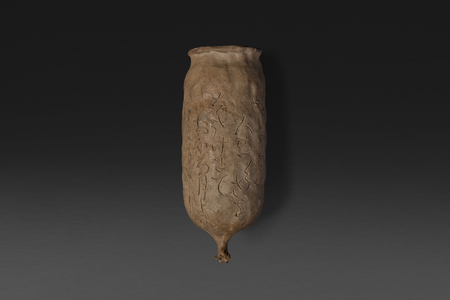Product Description
Otagaki Rengetsu (1791-1875)
A pottery kake hanaire (hanging flower vessel) in the form of a hechima (sponge gourd) incised with a poem
Signed Rengetsu
Japan 19th century Edo/Meiji period
Dimensions: H. 18cm x Diam. 7cm (7” x 2¾”)
An awase-bako (fitted wood box) inscribed:
Otagaki Rengetsu saku kake hanaire (Hanging flower vessel made by Otagaki Rengetsu)
Provenance: Hasegawa Hosai (date unknown), a sashimonoshi (fine woodwork master) who worked for sukisha (tea masters and tea utensils collectors) in the Chukyo region (Aichi prefecture).
Inscribed poem on vessel:
Yado kasanu
hito no tsurasa wo nasake nite
oboro tsukiyo no
hana no shita fushi
Turned away at the inn
I take this unkindness as grace…
resting instead
beneath the hazy moon
and evening blossoms.*
Otagaki Rengetsu composed this verse from the perspective of a traveller who was cold-heartedly rejected at an inn. Unable to sleep under a roof, she had to sleep outside. Seeing cherry blossom in full bloom under the moonlight, she interpreted her situation as an unexpected gift. This is one of the most representative poems by Rengetsu as there are multiple ceramic works and paintings with this poem known.
Rengetsu was in her lifetime a Buddhist nun, poet, calligrapher, potter and painter. Shortly after her birth in Kyoto to a samurai family with the surname Todo, she was adopted by Otagaki Mitsuhisa who worked at Chion’in, an important Jōdo (Pure Land) sect temple in Kyoto, and was given the name Nobu.
In 1798, having lost her mother and brother, she was sent to serve as a lady-in-waiting at Kameoka Castle in Tanba, where she studied poetry, calligraphy and martial arts, returning home at the age of 16 to marry a young samurai named Mochihisa. They had three children, all of whom died shortly after birth; in 1815 Mochihisa also died.
In 1819 Nobu remarried, but her second husband died in 1823. After enduring the tragic loss of two husbands and all her children, Nobu, only 33 years old, shaved her head and became a nun, at which time she adopted the name Rengetsu (Lotus Moon). She lived with her stepfather, who had also taken vows, near Chion’in. After his death in 1832 Rengetsu began to make pottery, which she then inscribed with her own waka (31-syllable classical poetry) and sold to support herself.
In 1875, having led a long and exceptional life, Rengetsu died in the simple Jinkōin tearoom in Kyoto where she had lived and worked for ten years. Jinkōin Temple is a Shingon School temple (Esoteric Buddhism); Rengestu was ordained as a nun in the Pure Land School (Jōdo Shū) but she also studied and practiced Zen and Esoteric Buddhism.
The delicate hand-built tea utensils that Rengetsu inscribed with hauntingly beautiful poems are unique combinations of poetry, calligraphy and pottery; they were as highly prized in her own lifetime as they are now. Rengetsu is also known to have inscribed her poems on utensils made by other Kyoto potters. In addition to ceramics, she also produced numerous gassaku (jointly created artworks) in the form of paintings, hanging scrolls, and calligraphic works with fellow literati artists and writers.
Works by Rengetsu can be found in the collections of various museums including: The Tokyo National Museum; The Metropolitan Museum of Art, NY; the Michigan Museum of Art; Los Angeles County Museum of Art; Smithonian’s National Museum of Asian Art, Washington DC; Asian Art Museum, San Francisco; Art Gallery of South Australia, Adelaide; Museum of Far Eastern Antiquities, Stockholm.
For more details of Rengestu and her works, see:
Frank Feltens, ed., Japan in the Age of Modernization: The Arts of Otagaki Rengetsu and Tomioka Tessai, (Washington, D.C., 2023);
National Gallery of Australia ed., Black Robe White Mist: art of the Japanese Buddhist nun Rengestu, (Canberra, 2007).
*Translation of the poem by the Rengetsu Foundation Project, Kyoto; John Walker and Kazuya Oyama (quoted in: Frank Feltens, ed., Japan in the Age of Modernization: The Arts of Otagaki Rengetsu and Tomioka Tessai, (Washington, D.C., 2023), p.68).









